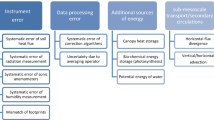Abstract
Analysis of profiles of meteorological measurements from a 160 m high mast at the National Test Site for wind turbines at Høvsøre (Denmark) and at a 250 m high TV tower at Hamburg (Germany) shows that the wind profile based on surface-layer theory and Monin-Obukhov scaling is valid up to a height of 50–80 m. At higher levels deviations from the measurements progressively occur. For applied use an extension to the wind profile in the surface layer is formulated for the entire boundary layer, with emphasis on the lowest 200–300 m and considering only wind speeds above 3 m s−1 at 10 m height. The friction velocity is taken to decrease linearly through the boundary layer. The wind profile length scale is composed of three component length scales. In the surface layer the first length scale is taken to increase linearly with height with a stability correction following Monin-Obukhov similarity. Above the surface layer the second length scale (L MBL ) becomes independent of height but not of stability, and at the top of the boundary layer the third length scale is assumed to be negligible. A simple model for the combined length scale that controls the wind profile and its stability dependence is formulated by inverse summation. Based on these assumptions the wind profile for the entire boundary layer is derived. A parameterization of L MBL is formulated using the geostrophic drag law, which relates friction velocity and geostrophic wind. The empirical parameterization of the resistance law functions A and B in the geostrophic drag law is uncertain, making it impractical. Therefore an expression for the length scale, L MBL , for applied use is suggested, based on measurements from the two sites.
Similar content being viewed by others
References
Arya SPS (1988) Introduction to micrometeorology. Academic Press, San Diego, California, 307 pp
Batchvarova E, Gryning S-E (1991) Applied Model for the growth of the daytime mixed layer. Boundary-Layer Meteorol 56:261–274
Blackadar AK (1962) The vertical distribution of wind and turbulent exchange in a neutral atmosphere. J Geophys Res 67:3095–3102
Blackadar AK, Tennekes H (1968) Asymptotic similarity in neutral barotrophic planetary boundary layers. J Atmos Sci 25:1015–1020
Brown AR, Beljaars ACM, Hersbach H (2006) Errors in parameterizations of convective boundary-layer turbulent momentum mixing. Quart J Roy Meteorol Soc 132:1859–1876
Brümmer B (1976) The coefficients of the mechanical resistance law over the trophical ocean. Contrib Atm Phys 49:299–305
Brümmer B (1991) Wind shear at tilted inversions. Boundary-Layer Meteorol 57:295–308
Busch NE, Panofsky HA (1968) Recent spectra of atmospheric turbulence. Quart J Roy Meteorol Soc 94:361–379
Businger J, Wyngaard JC, Izumi Y, Bradley EF (1971) Flux profile relationships in the atmospheric surface layer. J Atmos Sci 28:181–189
Caldwell DR, van Atta CW, Heland KH (1972) A laboratory study of the turbulent Ekman layer. Geophys Fluid Dyn 3:125–160
Carl DM, Tarbell TC, Panofsky HA (1973) Profiles of wind and temperature from towers over homogeneous terrain. J Atmos Sci 30:788–794
Dyer AJ (1974) A review of flux-profile relationships. Boundary-Layer Meteorol 7:363–372
Garratt JR, Wyngaard JC, Francey RJ (1982) Winds in the atmospheric boundary layer - prediction and observation. J Atmos Sci 39:1307–1316
Grachev AA, Fairall CW, Bradley EF (2000) Convective profile constants revisited. Boundary-Layer Meteorol 94:495–515
Hess GD, Garratt JR (2002a) Evaluating models of the neutral, barotrophic planetary boundary layer using integral measures: Part I. overview. Boundary-Layer Meteorol 104:333–358
Hess GD, Garratt JR (2002b) Evaluating models of the neutral, barotrophic planetary boundary layer using integral measures: Part II. modelling observed conditions. Boundary-Layer Meteorol 104:359–369
Holtslag AAM (1984) Estimates of diabatic wind speed profiles from near-surface weather observations. Boundary-Layer Meteorol 29:225–250
Högström U (1988) Non-dimensional wind and temperature profiles in the atmospheric surface layer: a re-evaluation. Boundary-Layer Meteorol 42:55–78
LeMone, MA, Zhou M, Moeng C-H, Lenschow DH, Miller LJ, Grossman RL (1999) An observational study of wind profiles in the baroclinic convective mixed layer. Boundary-Layer Meteorol 90:47–82
Mahrt L (1975) The influence of momentum advections on a well-mixed layer. Quart J Roy Meteorol Soc 101:1–12
Panofsky H (1973) Tower micrometeorology. In: Haugen DA (ed) Workshop on Micrometeorology, American Meteorological Society, pp 151–176
Rotach MW, Vogt R, Bernhofer C, Batchvarova E, Christen A, Clappier A, Feddersen B, Gryning S-E, Martucci G, Mayer H, Mitev V, Oke TR, Parlow E, Richner H, Roth M, Roulet Y-A, Ruffieux D, Salmond JA, Schatzmann M, Voogt JA (2005) BUBBLE – an urban boundary layer meteorology project. Theor Appl Climatol 81:231–261
Seibert P, Beyrich F, Gryning S-E, Joffre S, Rasmussen A, Tercier P (2000) Review and intercomparison of operational methods for the determination of the mixing height. Atmos Environ 34:1001–1027
Stull R (1988) An introduction to boundary layer meteorology. Kluwer Academic Publishers, Dordrecht, the Netherlands, 666 pp
Tennekes H (1973) Similarity laws and scale relations in planetary boundary layers. In: Haugen (ed) Workshop on Micrometeorology, American Meteorological Society, pp 177–216
Troen I, Petersen EL (1989) European Wind Atlas. Risø National Laboratory, Roskilde, Denmark, 656 pp
Yokoyama O Gamo M, Yamamoto S (1979) The vertical profiles of the turbulent quantities in the atmospheric boundary layer. J Meteorol Soc Japan 57(3):264–272
Zilitinkevich SS, Mironov DV (1996) A multi-limit formulation for the equilibrium depth of a stably stratified boundary layer. Boundary-Layer Meteorol 81:325–351
Zilitinkevich SS, Esau N (2002) On integral measures of the neutral barotrophic planetary boundary layer. Boundary-Layer Meteorol 104:371–379
Zilitinkevich SS, Esau N (2005) Resistance and heat-transfer laws for stable and neutral planetary boundary layers: old theory advanced and re-evaluated. Quart J Roy Meteorol Soc 131:1863–1892
Author information
Authors and Affiliations
Corresponding author
Rights and permissions
About this article
Cite this article
Gryning, SE., Batchvarova, E., Brümmer, B. et al. On the extension of the wind profile over homogeneous terrain beyond the surface boundary layer. Boundary-Layer Meteorol 124, 251–268 (2007). https://doi.org/10.1007/s10546-007-9166-9
Received:
Revised:
Accepted:
Published:
Issue Date:
DOI: https://doi.org/10.1007/s10546-007-9166-9




